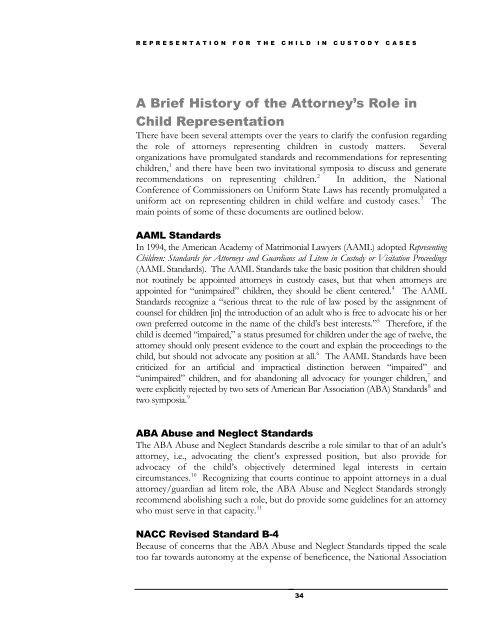A Judge’s Guide
A Judge’s Guide
A Judge’s Guide
You also want an ePaper? Increase the reach of your titles
YUMPU automatically turns print PDFs into web optimized ePapers that Google loves.
REPRESENTATION FOR THE CHILD IN CUSTODY CASES<br />
A Brief History of the Attorney’s Role in<br />
Child Representation<br />
There have been several attempts over the years to clarify the confusion regarding<br />
the role of attorneys representing children in custody matters. Several<br />
organizations have promulgated standards and recommendations for representing<br />
children, 1 and there have been two invitational symposia to discuss and generate<br />
recommendations on representing children. 2 In addition, the National<br />
Conference of Commissioners on Uniform State Laws has recently promulgated a<br />
uniform act on representing children in child welfare and custody cases. 3 The<br />
main points of some of these documents are outlined below.<br />
AAML Standards<br />
In 1994, the American Academy of Matrimonial Lawyers (AAML) adopted Representing<br />
Children: Standards for Attorneys and Guardians ad Litem in Custody or Visitation Proceedings<br />
(AAML Standards). The AAML Standards take the basic position that children should<br />
not routinely be appointed attorneys in custody cases, but that when attorneys are<br />
appointed for “unimpaired” children, they should be client centered. 4 The AAML<br />
Standards recognize a “serious threat to the rule of law posed by the assignment of<br />
counsel for children [in] the introduction of an adult who is free to advocate his or her<br />
own preferred outcome in the name of the child’s best interests.” 5 Therefore, if the<br />
child is deemed “impaired,” a status presumed for children under the age of twelve, the<br />
attorney should only present evidence to the court and explain the proceedings to the<br />
child, but should not advocate any position at all. 6 The AAML Standards have been<br />
criticized for an artificial and impractical distinction between “impaired” and<br />
“unimpaired” children, and for abandoning all advocacy for younger children, 7 and<br />
were explicitly rejected by two sets of American Bar Association (ABA) Standards 8 and<br />
two symposia. 9<br />
ABA Abuse and Neglect Standards<br />
The ABA Abuse and Neglect Standards describe a role similar to that of an adult’s<br />
attorney, i.e., advocating the client’s expressed position, but also provide for<br />
advocacy of the child’s objectively determined legal interests in certain<br />
circumstances. 10 Recognizing that courts continue to appoint attorneys in a dual<br />
attorney/guardian ad litem role, the ABA Abuse and Neglect Standards strongly<br />
recommend abolishing such a role, but do provide some guidelines for an attorney<br />
who must serve in that capacity. 11<br />
NACC Revised Standard B-4<br />
Because of concerns that the ABA Abuse and Neglect Standards tipped the scale<br />
too far towards autonomy at the expense of beneficence, the National Association<br />
34


